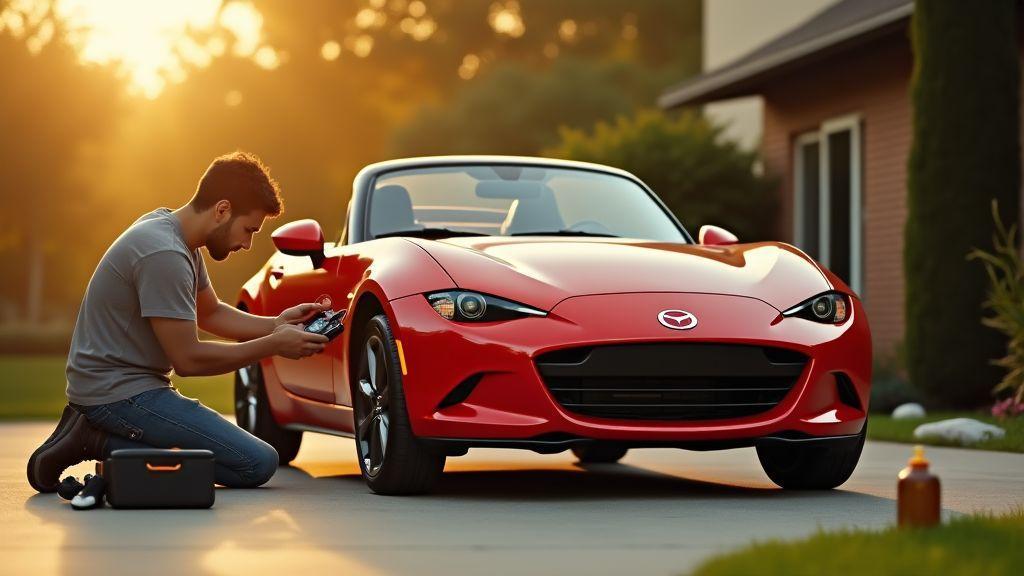Best Affordable Sports Cars for Beginners
“Best Affordable Sports Cars for Beginners” puts you on the fast track to a safe, fun first car. You will learn how to find reliable used models and cheap sports cars that fit a tight budget. The guide shows a clear pre-purchase inspection checklist, how to compare safety ratings and insurance costs, and what makes a car easy to drive for new drivers. You get tips on low maintenance choices, manual stick shift basics, and a simple budget plan for fuel, repairs, and insurance.
Key Takeaway
- Choose cars that keep your insurance and repair costs low
- Pick models that are reliable and easy for you to maintain
- Test drive to see if the car feels comfortable and easy for you to handle
- Favor cars with safety features that protect you
- Check resale value so your money holds up over time

Best Affordable Sports Cars for Beginners: Reliable used models and sports cars under $20,000 for beginners
You want a sports car that feels fun but won’t break the bank. Look for models with simple engines, good parts availability, and strong owner communities for DIY help. Cars like the Mazda MX-5 Miata and older Subaru BRZ/Scion FR‑S deliver lively handling and low running costs, which helps when you’re learning car control and parking in tight spots.
For a broader context on sports-car types and common models, see the Overview of common sports car models.
Buying used under $20,000 means trade-offs: higher miles are common, and some models need more care. Focus on cars with a clear service history, no flood or salvage titles, and parts that aren’t rare. If you pick a car with a reputation for reliability, you’ll spend more time driving than fixing.
Factor insurance, fuel, and common repairs into your budget. Some sporty cars carry higher premiums; others have cheap parts and easy repairs. Set a target total monthly cost—loan, insurance, gas, and a maintenance buffer—so you get a real picture of ownership before you sign.
How you can find cheap sports cars for beginners that fit your budget
Start with local listings and filter for max price and distance. Use saved searches and alerts on popular sites so you see new entries fast—cheap deals disappear quickly. Be ready to call or visit the same day.
Compare similar models across a few regions. A tidy car 100 miles away can be cheaper than a rough local one; factor in transport or a short trip. Ask sellers for test-drive times and service records—those clues show how the car was treated.
Best used sports cars for new drivers to research before you buy
Here are reliable options to research: Mazda MX‑5 Miata (NA/NB/NC), Subaru BRZ/Scion FR‑S, Nissan 350Z, Ford Mustang V6 (older), Mazda RX‑8, and Toyota MR2 Spyder. Each offers something different: lightweight balance, rear-wheel-drive fun, or affordable V6 power. Pick one that matches how you’ll use it—tight backroads, daily commute, or weekend cruising.
Look up common faults for each model and typical repair costs. For example, RX‑8 rotary engines need special attention and can be costly; the Miata is forgiving and cheap to fix. Use forums, owner groups, and service records to judge ongoing costs and find a local mechanic who knows the model.
| Model | Typical used price (US) | Why it fits beginners | Watch for |
|---|---|---|---|
| Mazda MX‑5 Miata | $6,000–$18,000 | Light, predictable handling; cheap parts | Rust, soft-top wear |
| Subaru BRZ / FR‑S | $12,000–$20,000 | Great balance and grip; modern safety | Tire wear, oil use |
| Nissan 350Z | $7,000–$18,000 | Strong V6, durable | Age-related wear, transmission sync |
| Ford Mustang (V6) | $5,000–$18,000 | Cheap power, easy to modify | Frame rust, older electronics |
| Mazda RX‑8 | $3,000–$12,000 | Fun rev-happy engine | Rotary maintenance, apex seals |
| Toyota MR2 Spyder | $6,000–$15,000 | Mid-engine feel, light weight | Limited space, timing belt service |
Checklist for pre-purchase inspection you can use
Before you buy, run this checklist and bring a mechanic if you can — or contact our team for recommendations in your area; you can also consult the government’s Used car pre-purchase inspection checklist for items to verify and recall checks:
- Engine oil level, smell, and leaks
- Compression or leak-down check (if possible)
- Service records and ownership history
- Title status (clean, salvage, flood)
- Test-drive: acceleration, shifting, braking, steering
- Suspension and shock condition; listen for clunks
- Brake pad thickness and rotor condition
- Tire tread depth and even wear pattern
- Check for frame damage, welds, or rust patches
- Cooling system: radiator, hoses, thermostat behavior
- A/C, heater and electrical components test
- Clutch slip (manual) or smooth shifts (auto)
Low insurance sports cars for beginners and why safety ratings matter
If you hunt for the Best Affordable Sports Cars for Beginners, think like an insurer. Insurers look first at crash test results, theft rates, and repair costs. A high safety score often means lower premiums because it signals lower injury risk and cheaper payouts after a claim.
Safety ratings reflect real-world protection. IIHS and NHTSA tests show how the car holds up in a crash. (See Check vehicle crash test ratings online for searchable results and test explanations insurers use.) Cars with strong ratings usually have better structure, airbags, and crash-avoidance tech, which lowers injury risk and can cut your annual insurance bill.
You also save when a car has common parts and simple repairs. Exotic body panels and rare engines drive repair bills up; insurers price that into premiums. Pick a sports car with widely available parts and modern safety tech, and you’ll be rewarded at renewal time.
How you pick beginner-friendly sports cars with strong safety features
Start with published ratings and a spec sheet. Look for good IIHS or NHTSA results, standard electronic stability control, and available automatic emergency braking. Those items reduce both crash risk and insurer concern—put them at the top of your checklist.
Next, compare real costs: average repair prices, theft statistics, and recall history. Talk to mechanics about common fixes and read vehicle history reports for used cars. A well-documented, low-theft model with common parts will be easier on your wallet and your insurer.
Easy-to-drive sports cars for beginners and traits that lower insurance
Choose cars with calm throttle response and predictable brakes. Beginners do better with smooth power delivery than raw acceleration. A forgiving chassis and clear steering let you learn limits without surprises, which cuts accident risk and keeps claims down.
Also favor practical traits insurers like: lower horsepower, anti‑theft systems, and active safety features such as parking sensors, daytime running lights, and stability control. These can earn discounts or lower risk classifications that drop your premium.
Safety and insurance documents you should compare
- IIHS and NHTSA crash test scores and notes
- Vehicle history report (Carfax, AutoCheck) for accidents and title issues
- Manufacturer recall and repair bulletins
- Insurance company loss history or CLUE report for theft/claim trends
- Repair cost estimates from local shops for typical body and mechanical work
- Your current policy declarations to match coverage and limits
| Safety Feature | Why it matters to insurers | Typical insurance effect |
|---|---|---|
| Good crash test scores | Lower injury risk in crashes | Lower bodily injury and medical payouts |
| Automatic emergency braking | Reduces front-end collisions | Fewer collision claims; possible discounts |
| Electronic stability control | Prevents loss-of-control crashes | Fewer single-vehicle claims |
| Common replacement parts | Cheaper and faster repairs | Lower collision and comprehensive costs |

Running costs, maintenance, and reliable budget sports cars as your affordable first sports car
You need to know what you’ll spend each year. Fuel, routine service, tires, brakes, and occasional repairs add up fast. Expect higher fuel use than a compact sedan, and plan for sport tires that wear quicker. Think in yearly rounds: fuel monthly, oil and filter twice a year, brakes and tires as needed, and one larger repair every few years. That gives you breathing room and keeps surprises small. For guidance on financing and planning total ownership costs, Plan a realistic used car budget with proven consumer finance tools.
Pick cars with simple engines and lots of parts available. Models with big aftermarket communities and common parts are cheaper to fix—hence why names like Mazda MX‑5 and Volkswagen GTI appear frequently when you search Best Affordable Sports Cars for Beginners. If you buy smart—a full service history, recent timing belt/chain work, and fresh tires—you can save thousands.
How to choose an affordable first sports car with low maintenance needs
- Set a total budget that includes purchase plus one year of running costs
- Target models known for reliability and cheap parts
- Check service history and get an inspection
- Compare insurance quotes before you buy
Grade each car by three things: mechanical simplicity, parts cost, and community support. Simple engines without exotic tech are easier to fix. Many owners mean used parts and DIY guides online. Insurance groups and local mechanic familiarity can cut your monthly bill. When you add those scores, the best choice usually looks less risky and more fun.
Best manual sports cars for novice drivers and tips to learn stick shift
Manual cars make you part of the drive, but choose one with a forgiving clutch and not-too-stiff gear throws. Great starter manuals are the Mazda MX‑5, Toyota 86 / Subaru BRZ, and older Honda Civic Si models. They are light, predictable, and have clutches that teach you without scaring you. Parts and guides are plentiful, keeping ownership cheap and learning stress low.
Learning stick shift is like learning to ride a bike: awkward at first, then second nature. Practice in an empty parking lot—find the clutch bite point, practice gentle takeoffs, and do hill starts until you’re calm. Use short trips to build smooth shifts, and ask a patient friend or instructor to watch your form. After a few weekends you’ll feel confident. Keep a calm pace; rushing makes stalls and stress.
Budget plan for fuel, repairs and insurance before you buy
Sketch a simple annual budget: estimate fuel based on miles and mpg, set aside a repair fund equal to one month’s car payment, and get three insurance quotes. Factor in tire replacement every 2–4 years for spirited drivers and a minor repair buffer for wear items like brakes and suspension.
| Car type | Fuel (year) | Repairs & Tires (year) | Insurance (year) | Estimated Total (year) |
|---|---|---|---|---|
| Small sports (MX‑5) | $700–$1,000 | $600–$1,000 | $900–$1,500 | $2,200–$3,500 |
| Hot hatch / compact coupe | $800–$1,200 | $700–$1,200 | $1,000–$1,800 | $2,500–$4,200 |
| Older used coupe (higher miles) | $900–$1,400 | $1,200–$2,500 | $1,200–$2,000 | $3,300–$5,900 |
Conclusion
If you’re searching for the Best Affordable Sports Cars for Beginners, prioritize reliability, low insurance and repair costs, and easy maintenance. Always test-drive and run the pre-purchase inspection checklist. Get multiple insurance quotes and set a realistic budget that includes fuel, tires, and a repair buffer. Favor cars with strong safety features, common parts, and active owner communities—those traits cut surprises and keep ownership manageable. Models like the Mazda MX‑5 Miata or Subaru BRZ/FR‑S strike a smart balance between thrill and affordability; choose a forgiving manual if you want to learn stick. Buy smart, and you’ll spend more time driving than fixing.
For more practical guides and model deep-dives, visit the Meridian Pioneer home page. Before sharing personal details for a sale or service, review our privacy policy and terms of use, or contact our team with questions.

